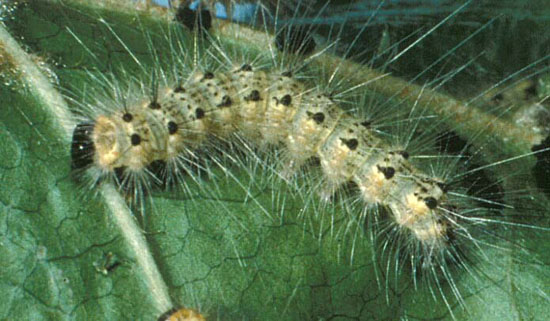Issue 12, August 1, 2017
Fall Webworm
Fall webworm is numerous throughout the state, particularly southern and central Illinois. It lives as a group of caterpillars that spin a communal silk web. This silk nest typically encloses the end of the branch and associated leaves. The caterpillars remain in the webbing, feeding on these enclosed leaves. When the leaves inside the web are eaten, the silk webbing is expanded to include more leaves. Webs of mature caterpillars are typically 2 to 3 feet long.

Fall webworm larva.
This insect has an extremely large host range, being found on almost any deciduous tree and some shrubs. It is most commonly found in Illinois landscapes on crabapple, walnut, hickory, pecan, redbud, sweet gum, maple, and oak.

Fall webworm damage to crabapple.
Loss of leaves from caterpillar feeding at this time of year has little impact on tree health as long as their loss does not trigger new bud break. If damage is limited to a few branches, new leaf production is unlikely to occur. Control at this time of year is primarily recommended to reduce aesthetic damage so fall webworm colonies at the tops of tall trees and in other less obvious locations can be ignored, depending on client preferences.
Pruning off the branch with its webbing and disposing of it is an effective control. Many insecticides are effective in controlling fall webworm. Bacillus thuringiensis kurstaki (Dipel, Thuricide, others), carbaryl (Sevin), pyrethroids, and other labeled insecticides are effective. However, the webbing is waterproof, making it spray resistant. Enough spray pressure is needed to break into the web and get the insecticide onto the leaves within the nest. Nest webs are typically expanded only every week or so, so insecticide deposited on leaves outside the webs is likely to break down before the caterpillars expand the webbing over treated leaves. (Phil Nixon)
Author:
Phil Nixon